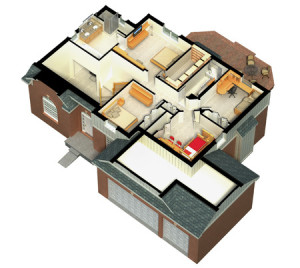 Building Information Modeling (BIM) is a fascinating process that is quickly revolutionizing the way we design and construct our built environment. It is so much more than software. It is better described as a process to be followed.
Building Information Modeling (BIM) is a fascinating process that is quickly revolutionizing the way we design and construct our built environment. It is so much more than software. It is better described as a process to be followed.
Using building information modeling, architects, engineers and contractors are able to model (or create three-dimensionally) nearly all of the components needed to construct their clients’ buildings. This includes everything from the piping and electric to the walls, room layout and more. It’s thanks to building information modeling, that construction projects are able to be completed on time and with fewer errors. Let’s take a closer look at this technology’s amazing capabilities.
Mechanical systems modeling
A building might look relatively simple on the outside, but just like the inside of the human body, it’s incredibly complex. Movie theaters, schools and even grocery stores are filled with complex networks of vents, wires, pipes and machinery that ensure each and every aspect of the building functions at full capacity.
Building information modeling is frequently used to design and conceive what a structure’s mechanical systems will look like. Mechanical systems include the air conditioning and heating units, as well as boilers, vents, piping and more. Since these necessary components make up the interior of any building, addressing them before breaking ground makes sense. Not only does this save potential setbacks or downtime, it also ensures that all aspects of the projects are taken into account during the design phase.
Electrical systems modeling
Building information modeling technology can also help to adequately design a project’s electrical systems. However, thanks to the internet and the rise of smart technologies, this process is becoming trickier every year. Lighting, wi-fi, power for servers and even security needs like CCTV monitors and security locks all require electricity.
BIM provides architects and contractors with key information and insights they can use in order to prevent injuries and ensure that a structure’s electrical systems are up to snuff.
Building and site concrete modeling
Once a building’s inner workings have been designed, it’s time to move onto the external structure. This is just as important as mechanical systems and electric because it will determine how strong a building is and how long it will last.
Using measurements and data provided by our clients, our building information modeling team can create a comprehensive real-time 3D model. Not only does this provide a living, breathing scale model of the project we’re working toward, it also allows us to see any issues that we may encounter during a build.
For example, a 3D model may illustrate that the mechanical systems design will directly interfere with an aspect of the electrical system. We can catch this error by evaluating our BIM model, and can then make adjustments on the computer. As you can imagine, this is much easier than uncovering a problem on the job site and then having to backtrack.
Modeling of historic structure (preservation)
Building information modeling can be used on existing structures as well. In fact, we regularly use this technology in our efforts to preserve historic or aging buildings. BIM tools allow us to get a complete picture of an existing structure. They can alert us to problems with the foundation or structure itself and can also provide us with insights that will allow us to fortify a building without causing any unnecessary damage or duress.
Call us to learn more about the benefits of BIM
As you can see, building information modeling is capable of some amazing things. Not only does it save time and money, it improves safety and prevents common errors. Whether you’re looking to preserve a historic building or are ready to break ground on a new structure entirely, the team at McNeil Engineering is here to help. Call us today to learn more! 888-303-7700








